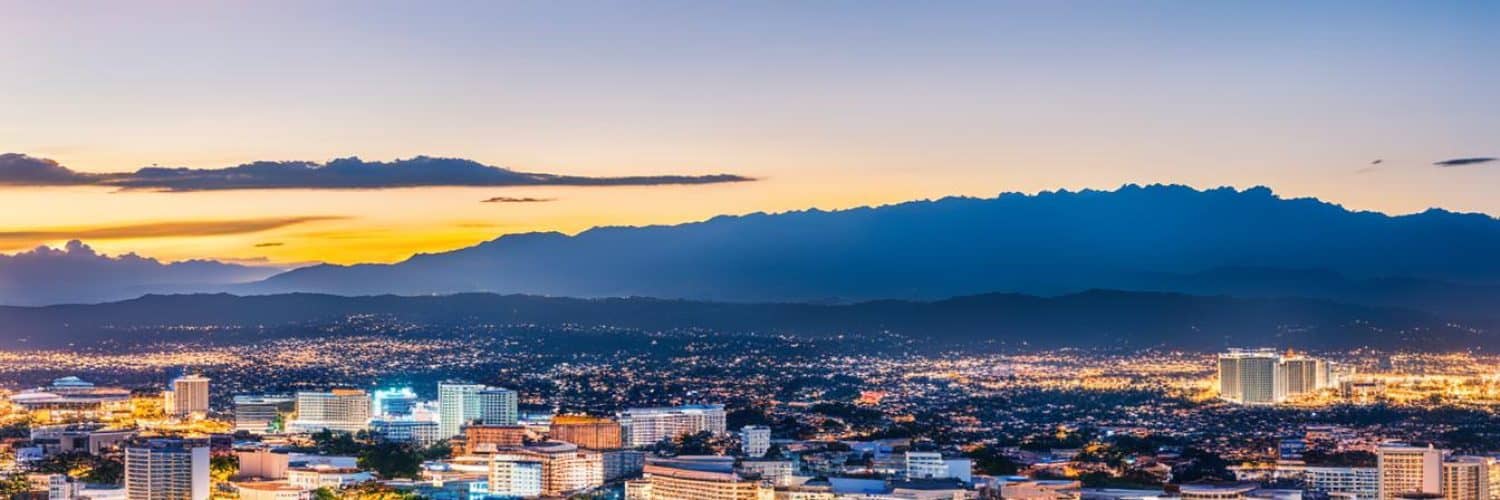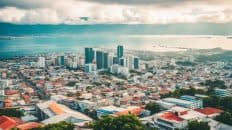Welcome to Cebu City, the vibrant urban center, historical treasure trove, and cultural hub nestled in the central part of the Philippines. But have you ever wondered why it is known as the “Queen City of the South”? What makes Cebu so unique and captivating? Let’s embark on a journey to uncover the secrets and wonders of this remarkable city.
Key Takeaways:
- Discover the historical and cultural significance of Cebu City.
- Explore the economic landscape and vibrant industries that drive the city’s growth.
- Immerse yourself in the rich cultural heritage and culinary delights of Cebu.
- Experience the stunning natural attractions that make Cebu a paradise for nature lovers.
- Examine the challenges and opportunities that Cebu City faces for its future development.
Historical Tapestry of Cebu
Cebu’s rich history is intricately woven with the arrival of Portuguese explorer Ferdinand Magellan in 1521, which marked the onset of Spanish colonial rule in the Philippines. This momentous event, encompassing Magellan’s landing in Cebu and the subsequent conversion of local chieftain Rajah Humabon and his followers to Christianity, played a pivotal role in shaping the country’s colonial past.
The city of Cebu boasts numerous historical landmarks that bear witness to its significant role in Philippine history. One such landmark is Magellan’s Cross, a wooden cross planted by Magellan upon his arrival. It symbolizes the advent of Christianity in the country and has become a revered site for locals and tourists alike.
The Basilica Minore del Santo Niño is another renowned tourist spot in Cebu, revered as the oldest Roman Catholic church in the Philippines. This grand church houses the Santo Niño de Cebu, the country’s oldest religious relic, and serves as the focal point for the annual Sinulog Festival, a vibrant celebration of Cebuano culture and devotion.
Fort San Pedro, the oldest triangular bastion fort in the Philippines, is also located in Cebu City. Built in the 16th century, this historic structure served as a defense against foreign invaders during the Spanish colonial period. Today, it offers visitors a captivating glimpse into Cebu’s colonial past and provides a peaceful space to appreciate history.
The historical tapestry of Cebu City is a testament to its vibrant past and the enduring influence of its colonial heritage. These landmarks invite visitors to step back in time and appreciate the rich cultural legacy that continues to shape the city’s identity.
Economic Landscape of Cebu City
In recent years, Cebu City has transformed into a thriving economic hub that plays a crucial role in driving the growth of the Philippines. With its strategic location and robust infrastructure, the city attracts numerous local and international businesses, making it a magnet for investment opportunities.
At the heart of Cebu City’s economic prowess are the Cebu Business Park and Cebu IT Park, two prominent business districts that cater to a range of industries. These well-planned developments house corporate offices, business process outsourcing (BPO) companies, and an array of commercial establishments, making them key attractions for entrepreneurs and job seekers alike.
The Cebu Business Park, located in the city center, is a vibrant business district that offers a mix of corporate giants and local enterprises. It provides a conducive environment for various sectors such as finance, real estate, and professional services to thrive. The park’s modern infrastructure, coupled with its proximity to major transportation networks, makes it an ideal destination for companies looking to establish their presence in Cebu City.
On the other hand, Cebu IT Park, also known as the Cebu Business Park IT Zone, focuses specifically on the information technology and business process management sector. It has become a magnet for BPO companies, attracting global giants and emerging startups alike. The park’s state-of-the-art facilities, modern office spaces, and access to a skilled workforce make it an ideal choice for businesses in the IT and BPO industries.
Cebu City’s economic landscape is not limited to these business districts. The city boasts a diverse range of industries that contribute to its overall economic growth. Manufacturing plays a key role, with Cebu serving as a major manufacturing hub for various sectors such as electronics, garments, furniture, and food processing. The city’s strategic location and excellent connectivity also make it a prime trading destination, supporting both domestic and international trade activities.
Furthermore, Cebu City’s thriving tourism industry also contributes significantly to its economic success. The city attracts visitors from around the world, seeking to explore its historical sites, natural attractions, and vibrant cultural scene. With a variety of Cebu City tour packages available, both domestic and international tourists can fully immerse themselves in the rich heritage and modern allure of the Queen City of the South.
In summary, Cebu City’s economic landscape is a dynamic blend of corporate powerhouses, burgeoning industries, and a thriving tourism sector. The city’s business districts, manufacturing capabilities, trade opportunities, and diverse cultural offerings continue to drive its growth and cement its reputation as a vital economic force in the Philippines.
Cultural Richness of Cebu City
Cebu City, a vibrant destination in the Philippines, is a melting pot of cultures, offering visitors a glimpse into its rich history and diverse traditions. The city’s cultural tapestry beautifully weaves together indigenous customs, Spanish influences, and contemporary expressions.
One of the highlights of Cebu’s cultural calendar is the Sinulog Festival, a grand celebration held every January. This vibrant event pays homage to the Santo Niño, the beloved child Jesus. Colorful parades, traditional dances, and lively street performances fill the city’s streets, creating an electric atmosphere that captivates both locals and tourists.
To delve deeper into Cebu’s cultural heritage, a visit to the University of San Carlos Museum is highly recommended. The museum houses a remarkable collection of artifacts and relics that narrate Cebu’s fascinating historical journey. From ancient pottery and sculptures to religious artifacts and artworks, the museum offers a captivating exploration of the city’s past.
“The University of San Carlos Museum is a treasure trove of Cebu’s history, with its vast collection of artifacts providing valuable insights into our cultural heritage.” – Dr. Maria Navarro, Cebu City Historian
Cebu City is also renowned for its culinary delights. One cannot visit the city without indulging in the famous lechon, a succulent whole roasted pig that is a testament to the city’s culinary prowess. Local delicacies such as danggit (dried fish), otap (flaky pastry), and chorizo de Cebu (local sausage) are also must-tries for food enthusiasts.
Immerse yourself in the cultural richness of Cebu City and discover the harmonious blend of traditions, festivals, and gastronomic delights that make this destination truly special.
| Famous Festivals | Highlight |
|---|---|
| Sinulog Festival | Colorful parades and street performances honoring the Santo Niño |
| Kadaugan sa Mactan | Commemoration of the Battle of Mactan, featuring reenactments and cultural presentations |
| Pasko sa Sugbo | Month-long Christmas celebration with festive lights, music, and performances |
Notable Delicacies:
- Lechon – Roasted whole pig
- Danggit – Dried fish
- Otap – Flaky pastry
- Chorizo de Cebu – Local sausage
Natural Attractions of Cebu
Cebu, the Queen City of the South, offers more than just historical landmarks and cultural richness. It boasts a stunning array of natural attractions that will take your breath away. Whether you love tranquil waterfalls, pristine beaches, or vibrant underwater ecosystems, Cebu has it all.

One of the most enchanting natural wonders in Cebu is Badian’s Kawasan Falls. Prepare to be mesmerized by the turquoise waters cascading down several levels, creating a picturesque backdrop for a refreshing dip or a thrilling canyoneering adventure. The vibrant beauty of the falls is truly a sight to behold.
If you’re a marine enthusiast, head to Moalboal, where you can immerse yourself in the mesmerizing underwater world. Moalboal’s marine biodiversity is breathtaking, making it a paradise for snorkelers and divers. Dive into the azure blue waters and get up close and personal with colorful coral reefs, turtles, and a captivating phenomenon known as the Sardine Run. Witness millions of sardines moving in perfect unison, creating a spectacle that will leave you in awe.
Another must-visit natural attraction in Cebu is Oslob, where you can swim with whale sharks. These gentle giants gracefully glide through the crystal-clear waters, allowing you to have a once-in-a-lifetime encounter. The experience of swimming alongside these magnificent creatures is both humbling and exhilarating, leaving you with unforgettable memories.
For those seeking panoramic views, a visit to Osmena Peak is a must. As the highest point in Cebu, it offers a breathtaking perspective of the surrounding landscapes. Standing atop this majestic peak, you’ll witness rolling hills, verdant valleys, and the azure sea stretching as far as the eye can see.
Here’s a list summarizing the best places to visit in Cebu:
- Kawasan Falls in Badian
- Moalboal’s vibrant underwater ecosystems
- Oslob for whale shark watching
- The panoramic beauty of Osmena Peak
- Sardine Run in Moalboal
Exploring the natural attractions in Cebu is an immersive experience that will leave you in awe of the island’s beauty. Whether you are seeking adventure, relaxation, or a chance to connect with nature, Cebu has something for everyone.
Challenges and Opportunities for Cebu City
While Cebu City has flourished as the Queen City of the South, it also faces various challenges that come with rapid urbanization and development. These challenges, however, present new opportunities for the city to grow and thrive in a sustainable manner.>
One of the primary challenges is traffic congestion. As more people migrate to Cebu City and the urban population continues to increase, the road infrastructure struggles to keep up with the rising demand. This issue hinders efficient transportation and affects the daily lives of residents and visitors alike.
Waste management is another pressing concern. The city grapples with the proper disposal of waste generated by its expanding population. Implementing effective waste management strategies, such as recycling programs and waste-to-energy initiatives, would help mitigate the environmental impact and promote a cleaner, greener Cebu.
“Cebu has immense potential to become a sustainable tourism destination, preserving its natural beauty and cultural heritage.” – Mayor of Cebu City
Cebu City is blessed with incredible natural beauty, including pristine beaches and vibrant marine ecosystems. However, as tourism continues to thrive, the challenge lies in balancing economic growth with environmental preservation. Sustainable tourism practices, such as responsible tour operations and support for local communities, hold the key to unlocking the city’s tourism potential while safeguarding its natural resources.
Strategic urban planning is essential to address the challenges faced by Cebu City. It involves creating smart and sustainable infrastructure solutions to alleviate traffic congestion, improving waste management systems, and promoting eco-friendly practices. Moreover, inclusive growth initiatives that prioritize the well-being and livelihoods of all residents will shape a more equitable future for the city.
Opportunities for Sustainable Development
Cebu City has the opportunity to become a model for sustainable development in the Philippines and beyond. By investing in smart infrastructure, such as efficient public transportation systems and pedestrian-friendly pathways, the city can alleviate traffic congestion and reduce carbon emissions. Additionally, implementing waste management technologies and promoting recycling initiatives will contribute to a more sustainable and eco-conscious future.
The development of eco-tourism sites can help promote the preservation of Cebu’s natural attractions while providing opportunities for responsible tourism. This includes creating nature reserves, organizing guided eco-friendly tours, and supporting local communities through sustainable tourism practices.
Furthermore, prioritizing green spaces and urban parks within Cebu City will enhance the quality of life for residents and visitors alike. These spaces not only contribute to a cleaner and healthier environment but also serve as recreational areas for leisure and relaxation.
Addressing the Challenges for a Better Future
Cebu City has already taken significant steps towards addressing its challenges. The local government continues to work closely with stakeholders, community organizations, and environmental advocates to develop and implement sustainable solutions.
Through strategic urban planning and inclusive growth initiatives, Cebu City is moving towards a future that prioritizes sustainable development, tourism, and the overall well-being of its residents. By embracing these opportunities and committing to a greener and more inclusive future, Cebu City can continue to thrive as the Queen City of the South.
Future Outlook for Cebu City
Cebu City, located in the Philippines, has a promising future ahead. As the city continues to grow and develop, there are key factors that will shape its trajectory. Embracing sustainable practices, preserving its cultural heritage, and adapting to the evolving global landscape are crucial for Cebu City’s success.
Investments in infrastructure, technology, and education will play a pivotal role in propelling Cebu City into a regional economic powerhouse. With a focus on developing modern infrastructure, including transportation networks and sustainable urban planning, Cebu City aims to attract more businesses and investors, stimulating economic growth and creating job opportunities for its residents.
“Cebu City is transforming into a dynamic and sustainable metropolis. Our goal is to create an environment that fosters innovation, attracts investments, and enhances the quality of life for our people.”
– Mayor of Cebu City, John G. Garcia
Cultural heritage is also a significant aspect of Cebu City’s future. Efforts to preserve historical landmarks and promote indigenous traditions will ensure that future generations can appreciate and learn from the city’s rich history. The preservation of cultural sites such as the Basilica Minore del Santo Niño and Fort San Pedro will continue to attract tourists and contribute to Cebu’s unique identity.
Adapting to the evolving global landscape is essential for Cebu City to maintain its competitiveness in the tourism industry. By embracing sustainable tourism practices, the city can protect its natural beauty and diverse ecosystems while offering visitors unique experiences. Collaborating with local communities and stakeholders will be crucial in ensuring that tourism benefits both the city and its people.
Investing in a Sustainable Future
Cebu City recognizes the importance of sustainable development and is committed to implementing initiatives that prioritize environmental conservation and social progress. This includes promoting renewable energy sources, reducing carbon emissions, and implementing waste management strategies that prioritize recycling and proper disposal.
Education is another key pillar for Cebu City’s future success. By investing in quality education and fostering a culture of continuous learning, the city aims to equip its residents with the skills and knowledge needed to thrive in an increasingly competitive global economy. This includes providing opportunities for advanced technical training and higher education.
With vigilant leadership and a collaborative approach, Cebu City is poised to navigate the challenges of the future while harnessing its potential for growth. By balancing progress with sustainability, preserving its cultural heritage, and embracing innovation, Cebu City will continue to shine as a beacon of development and opportunity in the Philippines.
Visit the Basilica Minore del Santo Niño
If you’re looking for a truly captivating experience in Cebu City, a visit to the Basilica Minore del Santo Niño is an absolute must. As the oldest Roman Catholic church in the Philippines, this iconic landmark holds the country’s oldest religious relic, the Santo Niño de Cebu. The basilica’s rich history and cultural significance make it a popular destination for tourists and devotees alike.
The Basilica Minore del Santo Niño is an architectural masterpiece that beautifully combines elements of Filipino spirituality and Spanish colonial influence. Its grand facade, adorned with intricate details and statues, exudes a sense of awe and reverence.
Inside the basilica, visitors can explore the vast interior, with its high ceilings, ornate altars, and beautiful stained glass windows. The ambiance is serene and tranquil, inviting reflection and prayer. Whether you’re a devout Catholic or simply intrigued by history and architecture, a tour of this sacred site will leave you inspired.
Don’t miss the chance to witness the devotees’ devotion during the regular novena and mass at the basilica. The heartfelt prayers and vibrant festivities showcase the profound faith and cultural heritage of the Filipino people.
Make sure to spend some time in the adjacent museum, which houses a collection of religious relics and artifacts, providing a deeper understanding of the basilica’s significance. The museum offers valuable insights into the religious and historical importance of the Santo Niño de Cebu, showcasing centuries-old artifacts and documents.
“Visiting the Basilica Minore del Santo Niño is like stepping back in time and immersing yourself in the rich cultural tapestry of Cebu. It’s a place of spiritual significance, architectural marvel, and historical treasure. A must-visit for anyone exploring the famous landmarks of Cebu.”
So, if you’re planning a trip to Cebu, be sure to include the Basilica Minore del Santo Niño in your itinerary. It’s a testament to the enduring faith and cultural heritage of the Filipino people, and an experience you won’t soon forget.
Explore Fort San Pedro
Fort San Pedro is a remarkable historical landmark that offers visitors a fascinating glimpse into Cebu’s colonial past. Constructed in the 16th century, it holds the distinction of being the oldest triangular bastion fort in the Philippines. Originally built as a defensive fortification against hostile invaders, Fort San Pedro now stands as a peaceful sanctuary for history enthusiasts and leisurely walks.
Upon setting foot inside the fortress, you’ll find yourself transported back in time. The fortified walls and watchtowers echo with stories of battles that were fought, while the well-preserved cannons serve as reminders of a tumultuous era. As you wander through the charming courtyard, take a moment to appreciate the stunning architecture that seamlessly combines Spanish influences with local craftsmanship.
Amidst the tranquil ambience, Fort San Pedro also houses a small museum that showcases artifacts and exhibits recounting Cebu’s rich historical journey. Delve into the narratives of the past through displays of ancient weaponry, pottery, navigational tools, and artwork. The museum provides a deeper understanding of Cebu’s role in shaping the country’s history and culture.
Revel in the panoramic views of Cebu City, as you make your way to the elevated vantage points within the fort. Look out onto the bustling cityscape and appreciate the stark contrast between past and present. The peaceful surroundings and scenic vistas make Fort San Pedro an ideal spot for quiet contemplation and reflection.
If you’re seeking respite from the hustle and bustle of modern life, Fort San Pedro offers a serene escape. Take a leisurely stroll along the cobblestone pathways, savoring the cool breeze and the sight of lush vegetation. As you explore the fort’s nooks and crannies, you’ll discover hidden corners that are perfect for finding moments of solitude amidst centuries of history.
In the words of a visitor, “Fort San Pedro is a living testament to Cebu’s enduring heritage. It transports you to a different time, allowing you to immerse yourself in a unique blend of history and tranquility.” Whether you’re a history enthusiast, a nature lover, or simply seeking a quiet respite, Fort San Pedro is a must-visit destination that will leave you with lasting memories.
Fort San Pedro at a Glance:
| Location | Cebu City, Philippines |
|---|---|
| Historical Significance | Oldest triangular bastion fort in the Philippines |
| Construction | Constructed in the 16th century |
| Architectural Style | Spanish colonial |
| Current Use | Museum and historical landmark |
| Highlights |
|
Swim with Whale Sharks in Oslob
Oslob, a coastal town in Cebu, offers a once-in-a-lifetime opportunity to swim with whale sharks, also known as gentle giants, in their natural habitat. This incredible experience allows visitors to witness these magnificent creatures up close and personal, creating a lasting memory of their time in Cebu.
The Philippines is one of the few places where you can encounter whale sharks in such proximity. These graceful creatures can grow up to 40 feet long and are known for their distinctive patterns of spots and stripes. Swimming alongside these majestic creatures is an awe-inspiring experience that offers a glimpse into their tranquil underwater world.
Whale shark encounters in Oslob are carefully monitored and regulated to ensure the safety of both the animals and visitors. Local guides are knowledgeable about the behavior and conservation of whale sharks and provide guidelines to ensure a responsible and sustainable experience.
During your swim, you’ll have the opportunity to observe the gentle giants as they glide effortlessly through the water, filter-feeding on plankton and small fish. The crystal-clear waters of Oslob allow for a unique perspective, as you witness these magnificent creatures in their natural environment.
Swimming with whale sharks in Oslob is a popular activity for tourists visiting Cebu. It’s important to note that this experience should be approached with respect for the animals and their habitat. Following the guidelines provided by the local authorities is essential in preserving the well-being and conservation of whale sharks.
“Swimming with whale sharks in Oslob was one of the most incredible experiences of my life. To be in the presence of such gentle and majestic creatures was truly awe-inspiring. It’s a must-do activity for anyone visiting Cebu!” – Sarah, avid traveler
How to Get to Oslob
Oslob is located approximately 120 kilometers southeast of Cebu City. Visitors can take a direct bus from the Cebu City South Bus Terminal to Oslob, with a travel time of around 3 to 4 hours depending on traffic. Another option is to hire a private car or join a guided tour, which may include additional attractions and activities in the area.
Tips for Swimming with Whale Sharks in Oslob
- Observe the guidelines provided by the local authorities and follow the instructions of your guide.
- Avoid touching the whale sharks or engaging in any disruptive behavior that could harm them or their environment.
- Use eco-friendly sunscreen to protect your skin without impacting the marine ecosystem.
- Bring a waterproof camera or GoPro to capture your unforgettable encounter with the whale sharks.
- Respect the natural habitat of the whale sharks and other marine life by not littering or damaging the coral reefs.
| Whale Shark Swimming in Oslob | Tour Package Details |
|---|---|
| Duration | Approximately 30 minutes |
| Inclusions |
|
| Best Time to Visit | Early morning, as the whale sharks tend to be more active during this time |
| Important Note | Swimming with the whale sharks is subject to weather conditions and the guidelines set by the local authorities |
Swimming with whale sharks in Oslob is an incredible opportunity to immerse yourself in the beauty of nature and witness one of the ocean’s most enchanting creatures. It’s an experience that will leave you with lasting memories of your visit to Cebu.
Canyoneering in Badian
Badian is a hidden gem in Cebu, offering thrilling canyoneering adventures that attract adrenaline junkies and nature enthusiasts alike. This outdoor activity allows visitors to immerse themselves in the breathtaking beauty of the region while experiencing an exhilarating journey through stunning gorges, turquoise pools, and cascading waterfalls.

The canyoneering experience in Badian is a perfect blend of adrenaline-pumping activities and awe-inspiring natural surroundings. As you navigate through the rugged terrain, you’ll have the opportunity to jump off cliffs and swim in crystal-clear waters. The highlight of the adventure is the jaw-dropping leap into the famous Kawasan Falls, a magnificent waterfall that will leave you in awe of its beauty and power.
Whether you’re a thrill-seeker looking for an adrenaline rush or a nature lover seeking an immersive outdoor experience, canyoneering in Badian is a must-do activity when exploring the best places to visit in Cebu. It offers an unforgettable adventure that combines the excitement of exploring untouched landscapes with the tranquility of being surrounded by nature’s wonders.
Why Choose Canyoneering in Badian?
Here are some reasons why canyoneering in Badian should be at the top of your Cebu itinerary:
- Thrilling Adventure: Experience the rush of jumping off cliffs and sliding down natural rock formations, creating memories that will last a lifetime.
- Natural Beauty: Immerse yourself in the stunning natural landscapes of Badian, surrounded by lush vegetation, towering cliffs, and pristine waters.
- Swimming in Paradise: Take a refreshing dip in the turquoise pools and swim in the crystal-clear waters of Badian’s canyons, offering a unique and unforgettable experience.
- Spectacular Waterfall: Conquer your fears and take the leap into the mesmerizing Kawasan Falls, surrounded by the lush tropical rainforest.
- Professional Guides: Explore Badian’s canyons with the guidance of experienced and knowledgeable local guides who prioritize safety while ensuring a fun and memorable experience.
Embark on a thrilling canyoneering adventure in Badian and discover why it is considered one of the best places to visit in Cebu. This adrenaline-fueled activity promises an unforgettable experience surrounded by the natural wonders of this beautiful region.
Sardine Run in Moalboal
Discover the mesmerizing Sardine Run in Moalboal, one of the best places to visit in Cebu. This natural spectacle showcases millions of sardines moving in perfect unison, creating a breathtaking underwater phenomenon. Snorkeling or diving in the crystal-clear waters of Moalboal allows visitors to witness this incredible display up close.
Immerse yourself in the vibrant marine ecosystem as the sardines dance gracefully through the ocean. As you explore the depths, you might also encounter majestic turtles gracefully gliding through the water, adding to the enchantment of your experience.
The Sardine Run in Moalboal is a must-see attraction for anyone seeking adventure and natural wonders. Whether you’re an experienced diver or a beginner snorkeler, this extraordinary spectacle will leave you in awe of Cebu’s diverse and magnificent underwater world.
Conclusion
Cebu City, known as the “Queen City of the South,” is a captivating destination that seamlessly blends history, culture, and natural beauty. Travelers can immerse themselves in the city’s rich heritage by exploring historical landmarks such as the Basilica Minore del Santo Niño and Fort San Pedro. For nature enthusiasts, Cebu offers a wealth of natural attractions, including the breathtaking Kawasan Falls and the mesmerizing Sardine Run in Moalboal.
But Cebu is not just about history and nature; it is a city that embraces progress and sustainable practices. As it continues to evolve, Cebu prioritizes the well-being of its residents and the preservation of its cultural heritage. From its bustling economic hubs like the Cebu Business Park to its vibrant festivals, the city reflects the perfect balance of tradition and modernity.
Whether you are drawn to Cebu’s historical significance, its colorful festivals, or its stunning natural attractions, the “Queen City of the South” promises an unforgettable experience. With each visit, you will discover new facets of this dynamic city, leaving you with cherished memories and a desire to return.


















Add comment